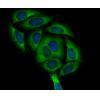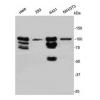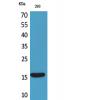-

专业包装 正品保证
-

快乐服务 售后无忧
-

会员特权 优惠不断
-

个人信息 严格保护
| 别名: | AKR1C1 | ||
|---|---|---|---|
| 适用物种: | Human, Mouse | ||
| 验证应用: | WB,IHC-P,ICC,FC | ||
| 种属: | 小鼠单抗 | ||
| 储存条件: | -20℃ | ||
![Anti-AKR1C1 antibody [5-F10]](images/202012/goods_img/92015_G_1606897355052.jpg)
|
| 货号 | 规格 | 可用库存 | 销售价(RMB) | 您的折扣价(RMB) | 购买数量 |
|---|
| 熔点: | |
|---|---|
| 密度: | |
| 储存条件: | -20℃ |
Anti-AKR1C1 antibody [5-F10]
WB: 1:2,000-1:10,000
ICC: 1:50-1:200
IHC-P: 1:50-1:200
FC: 1:50-1:100

Fig1: Western blot analysis of AKR1C1 on different lysates using anti-AKR1C1 antibody at 1/2,000 dilution.
Positive control:
Lane 1: HepG2
Lane 2: Human liver tissue

Fig2: ICC staining AKR1C1 (green) in MCF-7 cells. The nuclear counter stain is DAPI (blue). Cells were fixed in paraformaldehyde, permeabilised with 0.25% Triton X100/PBS.

Fig3: Immunohistochemical analysis of paraffin-embedded human liver tissue using anti-AKR1C1 antibody. Counter stained with hematoxylin.

Fig4: Immunohistochemical analysis of paraffin-embedded human pancreas tissue using anti-AKR1C1 antibody. Counter stained with hematoxylin.

Fig5: Immunohistochemical analysis of paraffin-embedded mouse kidney tissue using anti-AKR1C1 antibody. Counter stained with hematoxylin.

Fig6: Flow cytometric analysis of HepG2 cells with AKR1C1 antibody at 1/100 dilution (red) compared with an unlabelled control (cells without incubation with primary antibody; black). Alexa Fluor 488-conjugated goat anti mouse IgG was used as the secondary antibody.
特别提示:本公司的所有产品仅可用于科研实验,严禁用于临床医疗及其他非科研用途!
















